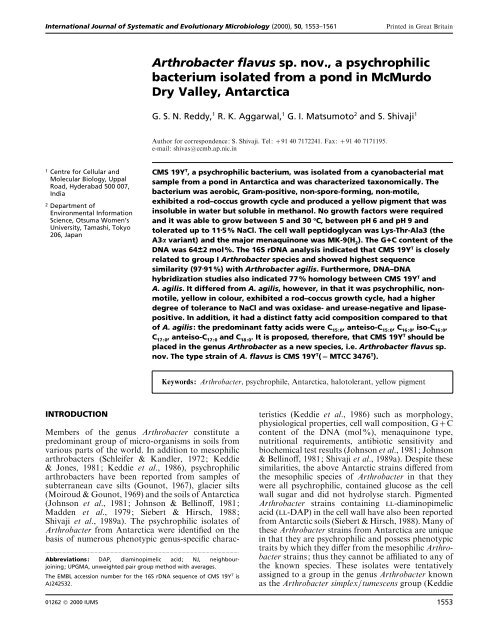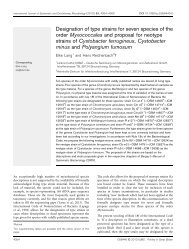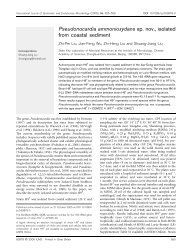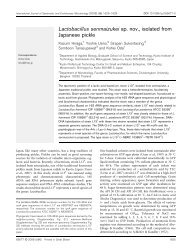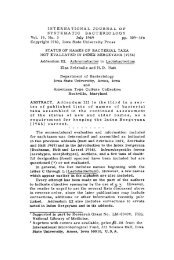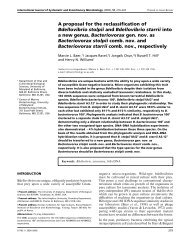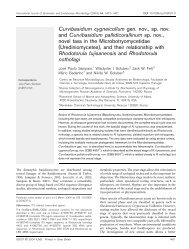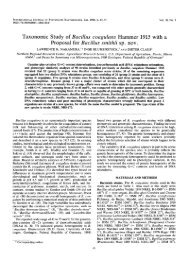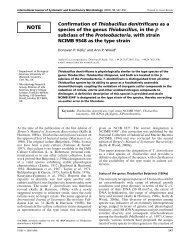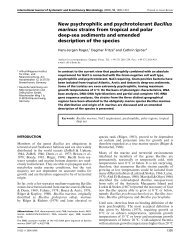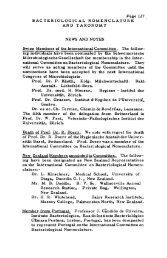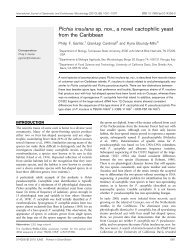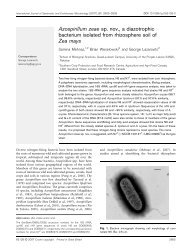Arthrobacter flavus sp. nov., a psychrophilic bacterium isolated from ...
Arthrobacter flavus sp. nov., a psychrophilic bacterium isolated from ...
Arthrobacter flavus sp. nov., a psychrophilic bacterium isolated from ...
You also want an ePaper? Increase the reach of your titles
YUMPU automatically turns print PDFs into web optimized ePapers that Google loves.
International Journal of Systematic and Evolutionary Microbiology (2000), 50, 1553–1561 Printed in Great Britain<br />
1 Centre for Cellular and<br />
Molecular Biology, Uppal<br />
Road, Hyderabad 500 007,<br />
India<br />
2 Department of<br />
Environmental Information<br />
Science, Otsuma Women’s<br />
University, Tamashi, Tokyo<br />
206, Japan<br />
INTRODUCTION<br />
Members of the genus <strong>Arthrobacter</strong> constitute a<br />
predominant group of micro-organisms in soils <strong>from</strong><br />
various parts of the world. In addition to mesophilic<br />
arthrobacters (Schleifer & Kandler, 1972; Keddie<br />
& Jones, 1981; Keddie et al., 1986), <strong>psychrophilic</strong><br />
arthrobacters have been reported <strong>from</strong> samples of<br />
subterranean cave silts (Gounot, 1967), glacier silts<br />
(Moiroud & Gounot, 1969) and the soils of Antarctica<br />
(Johnson et al., 1981; Johnson & Bellinoff, 1981;<br />
Madden et al., 1979; Siebert & Hirsch, 1988;<br />
Shivaji et al., 1989a). The <strong>psychrophilic</strong> isolates of<br />
<strong>Arthrobacter</strong> <strong>from</strong> Antarctica were identified on the<br />
basis of numerous phenotypic genus-<strong>sp</strong>ecific charac-<br />
.................................................................................................................................................<br />
Abbreviations : DAP, diaminopimelic acid; NJ, neighbourjoining;<br />
UPGMA, unweighted pair group method with averages.<br />
The EMBL accession number for the 16S rDNA sequence of CMS 19YT is<br />
AJ242532.<br />
<strong>Arthrobacter</strong> <strong>flavus</strong> <strong>sp</strong>. <strong>nov</strong>., a <strong>psychrophilic</strong><br />
<strong>bacterium</strong> <strong>isolated</strong> <strong>from</strong> a pond in McMurdo<br />
Dry Valley, Antarctica<br />
G. S. N. Reddy, 1 R. K. Aggarwal, 1 G. I. Matsumoto 2 and S. Shivaji 1<br />
Author for corre<strong>sp</strong>ondence: S. Shivaji. Tel: �91 40 7172241. Fax: �91 40 7171195.<br />
e-mail: shivas�ccmb.ap.nic.in<br />
CMS 19Y T , a <strong>psychrophilic</strong> <strong>bacterium</strong>, was <strong>isolated</strong> <strong>from</strong> a cyanobacterial mat<br />
sample <strong>from</strong> a pond in Antarctica and was characterized taxonomically. The<br />
<strong>bacterium</strong> was aerobic, Gram-positive, non-<strong>sp</strong>ore-forming, non-motile,<br />
exhibited a rod–coccus growth cycle and produced a yellow pigment that was<br />
insoluble in water but soluble in methanol. No growth factors were required<br />
and it was able to grow between 5 and 30 SC, between pH 6 and pH 9 and<br />
tolerated up to 11�5% NaCl. The cell wall peptidoglycan was Lys-Thr-Ala3 (the<br />
A3α variant) and the major menaquinone was MK-9(H 2 ). The GMC content of the<br />
DNA was 64O2 mol%. The 16S rDNA analysis indicated that CMS 19Y T is closely<br />
related to group I <strong>Arthrobacter</strong> <strong>sp</strong>ecies and showed highest sequence<br />
similarity (97�91%) with <strong>Arthrobacter</strong> agilis. Furthermore, DNA–DNA<br />
hybridization studies also indicated 77% homology between CMS 19Y T and<br />
A. agilis. It differed <strong>from</strong> A. agilis, however, in that it was <strong>psychrophilic</strong>, nonmotile,<br />
yellow in colour, exhibited a rod–coccus growth cycle, had a higher<br />
degree of tolerance to NaCl and was oxidase- and urease-negative and lipasepositive.<br />
In addition, it had a distinct fatty acid composition compared to that<br />
of A. agilis: the predominant fatty acids were C 15:0 , anteiso-C 15:0 ,C 16:0 , iso-C 16:0 ,<br />
C 17:0 , anteiso-C 17:0 and C 18:0 . It is proposed, therefore, that CMS 19Y T should be<br />
placed in the genus <strong>Arthrobacter</strong> as a new <strong>sp</strong>ecies, i.e. <strong>Arthrobacter</strong> <strong>flavus</strong> <strong>sp</strong>.<br />
<strong>nov</strong>. The type strain of A. <strong>flavus</strong> is CMS 19Y T (� MTCC 3476 T ).<br />
Keywords: <strong>Arthrobacter</strong>, psychrophile, Antarctica, halotolerant, yellow pigment<br />
teristics (Keddie et al., 1986) such as morphology,<br />
physiological properties, cell wall composition, G�C<br />
content of the DNA (mol%), menaquinone type,<br />
nutritional requirements, antibiotic sensitivity and<br />
biochemical test results (Johnson et al., 1981; Johnson<br />
& Bellinoff, 1981; Shivaji et al., 1989a). De<strong>sp</strong>ite these<br />
similarities, the above Antarctic strains differed <strong>from</strong><br />
the mesophilic <strong>sp</strong>ecies of <strong>Arthrobacter</strong> in that they<br />
were all <strong>psychrophilic</strong>, contained glucose as the cell<br />
wall sugar and did not hydrolyse starch. Pigmented<br />
<strong>Arthrobacter</strong> strains containing ll-diaminopimelic<br />
acid (ll-DAP) in the cell wall have also been reported<br />
<strong>from</strong> Antarctic soils (Siebert & Hirsch, 1988). Many of<br />
these <strong>Arthrobacter</strong> strains <strong>from</strong> Antarctica are unique<br />
in that they are <strong>psychrophilic</strong> and possess phenotypic<br />
traits by which they differ <strong>from</strong> the mesophilic <strong>Arthrobacter</strong><br />
strains; thus they cannot be affiliated to any of<br />
the known <strong>sp</strong>ecies. These isolates were tentatively<br />
assigned to a group in the genus <strong>Arthrobacter</strong> known<br />
as the <strong>Arthrobacter</strong> simplex�tumescens group (Keddie<br />
01262 � 2000 IUMS 1553
G. S. N. Reddy and others<br />
& Jones, 1981; Johnson et al., 1981; Johnson &<br />
Bellinoff, 1981; Siebert & Hirsch, 1988). <strong>Arthrobacter</strong><br />
simplex and <strong>Arthrobacter</strong> tumescens have now been<br />
reclassified as Pimelobacter simplex and Pimelobacter<br />
tumescens (Suzuki & Komagata, 1983a, b).<br />
All of the <strong>sp</strong>ecies of the genus <strong>Arthrobacter</strong> are Grampositive,<br />
catalase-positive, aerobic and a<strong>sp</strong>orogenous<br />
bacilli with a coryneform morphology (Schleifer &<br />
Kandler, 1972) and have been separated into two<br />
groups on the basis of their peptidoglycan, which<br />
contains lysine as the diamino acid. Group I <strong>sp</strong>ecies of<br />
<strong>Arthrobacter</strong> contain the A3α peptidoglycan variant in<br />
which cross-linkage of murein is brought about by<br />
interpeptide bridges involving monocarboxylic lamino<br />
acids or glycine or both, as observed in most<br />
<strong>sp</strong>ecies of <strong>Arthrobacter</strong> including <strong>Arthrobacter</strong> globiformis,<br />
the type strain of the genus (Stackebrandt et al.,<br />
1983). The group II <strong>sp</strong>ecies of <strong>Arthrobacter</strong> possess the<br />
A4α peptidoglycan variant in which the peptidoglycan<br />
type is l-Lys-Ala-Glu, as in <strong>Arthrobacter</strong> nicotianae,<br />
<strong>Arthrobacter</strong> uratoxydans, <strong>Arthrobacter</strong> protophormiae<br />
(Schleifer & Kandler, 1972; Stackebrandt et al., 1983),<br />
or l-Lys-l-Glu, as in <strong>Arthrobacter</strong> sulfureus<br />
(Stackebrandt et al., 1995; Funke et al., 1996). Recently,<br />
<strong>Arthrobacter</strong> rhombi, a new <strong>sp</strong>ecies (<strong>isolated</strong><br />
<strong>from</strong> Greenland halibut) with A4α peptidoglycan, was<br />
also included in <strong>Arthrobacter</strong> group II (Osorio et al.,<br />
1999). Phylogenetic studies indicate that certain Micrococcus<br />
<strong>sp</strong>ecies such as Micrococcus agilis, Micrococcus<br />
lylae and Micrococcus luteus are intermixed with the<br />
<strong>sp</strong>ecies of <strong>Arthrobacter</strong> (Stackebrandt et al., 1995) and<br />
detailed phylogenetic analysis along with phenotypic<br />
similarities have resulted in the reclassification of M.<br />
agilis as <strong>Arthrobacter</strong> agilis (Koch et al., 1995). The<br />
genus also includes a number of other <strong>sp</strong>ecies for<br />
which the chemotaxonomic data are lacking, e.g.<br />
<strong>Arthrobacter</strong> mysorens, <strong>Arthrobacter</strong> picolinophilus,<br />
<strong>Arthrobacter</strong> radiotolerans and <strong>Arthrobacter</strong> siderocapsulatus<br />
(Keddie et al., 1986). Detailed studies have<br />
now reclassified A. picolinophilus as Rhodococcus<br />
erythropolis (Koch et al., 1995) and A. radiotolerans as<br />
Rubrobacter radiotolerans (Suzuki et al., 1989). It has<br />
also been shown that A. mysorens is distinct <strong>from</strong><br />
the <strong>Arthrobacter</strong> <strong>sp</strong>ecies recognized up to 1983<br />
(Stackebrandt et al., 1983). Furthermore, many other<br />
<strong>sp</strong>ecies that were included in the genus <strong>Arthrobacter</strong><br />
(e.g. <strong>Arthrobacter</strong> duodecadis, <strong>Arthrobacter</strong> viscosus,<br />
<strong>Arthrobacter</strong> variabilis, A. simplex and A. tumescens)<br />
have now been excluded since they contain meso-DAP<br />
or ll-DAP in the peptidoglycan (Stackebrandt et al.,<br />
1983).<br />
In the present study, CMS 19YT, a <strong>psychrophilic</strong><br />
<strong>bacterium</strong> <strong>isolated</strong> <strong>from</strong> a cyanobacterial mat growing<br />
luxuriously in a pond in McMurdo Dry Valley,<br />
Antarctica, has been identified as belonging to the<br />
genus <strong>Arthrobacter</strong>. It possessed most of the phenotypic<br />
characteristics of <strong>Arthrobacter</strong>. Furthermore, the<br />
phylogenetic analysis based on the 16S rRNA gene of<br />
CMS 19YT also indicated that it is closely related to<br />
group I <strong>Arthrobacter</strong> <strong>sp</strong>p., which contain A3α-variant<br />
peptidoglycan. It differed, however, <strong>from</strong> all of the<br />
reported mesophilic and <strong>psychrophilic</strong> <strong>sp</strong>ecies with<br />
re<strong>sp</strong>ect to many characteristics and was therefore<br />
designated as a new <strong>sp</strong>ecies, for which we propose the<br />
name <strong>Arthrobacter</strong> <strong>flavus</strong> <strong>sp</strong>. <strong>nov</strong>.<br />
METHODS<br />
Source of the organism, media and growth conditions.<br />
Cyanobacterial mat samples were collected during the<br />
austral summer <strong>from</strong> the shores of an unnamed pond,<br />
designated E4 (77� 31� 7� S, 160� 45� 4� E), <strong>from</strong> the labyrinth<br />
of the Wright Valley, a constituent valley of McMurdo Dry<br />
Valley, Antarctica (Matsumoto, 1993; Matsumoto et al.,<br />
1993). The sample was initially analysed microscopically<br />
(�1000) and found to contain Phormidium laminosum as the<br />
most abundant cyano<strong>bacterium</strong> and also contained some<br />
green algae (Matsumoto et al., 1993).<br />
For the detection of bacteria, a piece of the above cyanobacterial<br />
mat sample (approx. 200 mg) was su<strong>sp</strong>ended in<br />
a tube containing 1 ml sterile saline (150 mM NaCl),<br />
teased with a glass rod and vortexed for approximately<br />
2–5 min to obtain a su<strong>sp</strong>ension. An aliquot of the su<strong>sp</strong>ension<br />
(100 µl) was plated on Antarctic Bacterial Medium (ABM)<br />
plates containing 0�5% (w�v) peptone, 0�1% (w�v) yeast<br />
extract and 1�5%(w�v) agar (pH 6�9) and incubated at 10 �C<br />
(Shivaji et al., 1988, 1989a, b, 1991, 1992). The appearance of<br />
colonies was monitored on a regular basis and pure cultures<br />
of the bacteria were established. One of the pure cultures<br />
thus established was yellow in colour and was designated<br />
CMS 19YT. The optimal temperature, pH and salt concentration<br />
for the growth of CMS 19YT were determined by<br />
using ABM plates.<br />
Morphology and motility tests. Cultures of CMS 19YT in the<br />
lag-, log- and stationary phases of growth were observed<br />
under a phase-contrast microscope (1000�) to ascertain<br />
their shape and motility. Motility was also determined by the<br />
hanging drop method and staining of the flagellum was done<br />
by the method of silver impregnation (Blenden & Goldberg,<br />
1965) using Pseudomonas aeruginosa as a positive control.<br />
Biochemical characteristics. All of the tests were performed<br />
by growing the culture at 20 �C in the appropriate medium.<br />
The activities of catalase, oxidase, pho<strong>sp</strong>hatase, gelatinase,<br />
urease, arginine dihydrolase and β-galactosidase were determined<br />
according to standard methods (Holding & Collee,<br />
1971). The production of indole, the utilization of citrate, the<br />
reduction of nitrate to nitrite and the hydrolysis of starch,<br />
aesculin and Tween 80 were measured according to the<br />
procedures described elsewhere (Stanier et al., 1966; Holding<br />
& Collee, 1971; Stolp & Gadkari, 1981). The utilization of<br />
six different sugars, leading to the formation of acid with or<br />
without gas production, was monitored according to Hugh<br />
& Leifson (1953).<br />
Fifty-four different carbon compounds were used to check<br />
the ability of the culture to utilize a carbon compound<br />
provided as the sole carbon source, using minimal medium<br />
without glucose but containing 0�2% (w�v) of the carbon<br />
source (Shivaji et al., 1988, 1989a, b, 1992). The sensitivity of<br />
the culture to 24 different antibiotics was determined using<br />
antibiotic discs (HiMedia).<br />
Preparation of DNA and G�C content. DNA was <strong>isolated</strong><br />
according to the procedure of Marmur (1961) and the G�C<br />
content (mol%) was determined <strong>from</strong> the melting point (T )<br />
m<br />
curves obtained using a Hitachi Spectrophotometer as<br />
1554 International Journal of Systematic and Evolutionary Microbiology 50
described earlier (Shivaji et al., 1989a, b, 1991, 1992). The<br />
equation of Schildkraut & Leifson (1965) was used to<br />
calculate the G�C content (mol%) of the DNA.<br />
DNA–DNA hybridization. DNA–DNA hybridization between<br />
CMS 19YT and A. agilis DNA was performed by<br />
using the membrane filter method (Tourova & Anto<strong>nov</strong>,<br />
1987) according to the protocol described earlier (Shivaji et<br />
al., 1992). DNA was denatured by boiling in 0�2 M NaOH<br />
for 5 min and then quickly chilling on ice and neutralizing<br />
with HCl. Denatured DNA was dotted on to nitrocellulose<br />
and immobilized by baking at 80 �C for 2 h. The filters with<br />
the fixed DNA were prehybridized in a buffer containing 4�<br />
SSC (1� SSC is 0�15 M NaCl plus 0�015 M sodium citrate),<br />
5� Denhardt’s medium (Denhardt, 1966), calf-thymus<br />
DNA (100 µg ml−�) and 1% SDS for 2 h at 60 �C and then<br />
hybridized in the same buffer under similar conditions but in<br />
the presence of labelled DNA. DNA was labelled by nick<br />
translation (Rigby et al., 1977).<br />
Analysis of cellular fatty acids. Cellular fatty acid methyl<br />
esters were obtained using the method described by Stead et<br />
al. (1992) and were separated by GC on an Hewlett-Packard<br />
HP-5-type silicon capillary column (25 m�0�25 mm). The<br />
fatty acids were identified by comparison with fatty acid<br />
standards run under similar gas chromatographic conditions<br />
and also by MS (VG AUTOSPEC) (Shivaji et al., 1992).<br />
Analysis of isoprenoid quinones. Menaquinones were<br />
extracted as described by Collins et al. (1977) and were<br />
separated by TLC using petroleum ether and diethyl ether<br />
(85:15, v�v). The menaquinone band corre<strong>sp</strong>onding to an<br />
R value of 0�7 was separated, eluted with chloroform and<br />
F<br />
further resolved into individual menaquinones by TLC,<br />
using silica-gel plates impregnated with silver nitrate with<br />
15% methyl ethyl ketone in hexane as the solvent system<br />
(Dumphy et al., 1971). The identities of the individual<br />
menaquinones were also confirmed by MS.<br />
Analysis of polar lipids. Lyophilized cell pellets washed free<br />
of medium were used for the extraction of polar lipids by the<br />
method of Minnikin et al. (1975) and were identified by<br />
TLC.<br />
Peptidoglycan analysis. Peptidoglycan was prepared according<br />
to the method described by Rosenthal & Dziarski (1994).<br />
The peptidoglycan thus obtained was hydrolysed with 4 M<br />
HCl at 120 �C for 60 min. The hydrolysate was vacuumdried<br />
and the amino acids were extracted into acetate buffer<br />
(pH 4�6) and subjected to amino acid analysis on an<br />
automated amino acid analyser (model 80-2086-6314;<br />
Pharmacia). The composition of the peptidoglycan was<br />
determined according to the method of Schleifer & Kandler<br />
(1972).<br />
Cell wall sugars. Cell wall sugars were prepared and analysed<br />
according to the method described by Komagata & Suzuki<br />
(1987).<br />
Bacterial pigment analysis. Lyophilized cells of CMS 19YT<br />
were su<strong>sp</strong>ended, extracted with methanol, centrifuged and<br />
the clear yellow supernatant recovered; the absorption<br />
<strong>sp</strong>ectrum was recorded in a Hitachi 330 <strong>sp</strong>ectrophotometer<br />
(Jagannadham et al., 1991; Shivaji et al., 1992; Chauhan &<br />
Shivaji, 1994).<br />
PCR amplification of the 16S rRNA gene. The small-subunit<br />
rRNA gene was amplified using the two primers 16S1 (5�-<br />
GAGTTTGATCCTGGCTCA-3�) and 16S2 (5�-ACGGC-<br />
TACCTTGTTACGACTT-3�), which are complementary<br />
to the conserved regions at the 5�- and 3� ends of the 16S<br />
<strong>Arthrobacter</strong> <strong>flavus</strong> <strong>from</strong> Antarctica<br />
rRNA gene corre<strong>sp</strong>onding to positions 9–27 and 1477–1498<br />
of the Escherichia coli 16S rRNA gene (Lane, 1991). The<br />
bacterial DNA (0�5 µg) was amplified by the PCR in a total<br />
volume of 50 µl containing 0�5 UTaq DNA polymerase,<br />
10 mM TAPS, pH 8�8, 3 mM MgCl � , 50 mM KCl, 0�01%<br />
gelatin, 10 pmol of each of the two primers and 200 µM each<br />
of dATP, dCTP, dGTP and TTP. The amplification of DNA<br />
was carried out in a hot-air rapid thermocycler (model no.<br />
1833; Idaho Technologies) programmed for 40 cycles of<br />
denaturation at 94 �C for 10 s, annealing at 48 �C for 20 s<br />
and extension at 72 �C for 30 s. A final extension of 5 min<br />
was carried out at 72 �C. In all of the amplification reactions,<br />
water was used in place of DNA for negative controls. The<br />
amplified DNA fragment (1�5 kb) was separated on 1%<br />
agarose gel, eluted <strong>from</strong> the gel and purified using the Clean<br />
Genei Kit (Bangalore Genei). The purified PCR product was<br />
used directly for DNA sequencing.<br />
16S rRNA gene sequencing. The purified 1�5 kb DNA<br />
product was sequenced using the primers 16S1 and 16S2<br />
and, in addition, a set of five forward primers [pB<br />
(TAACACATGCAAGTCGAACG), 50–70; pC (CTACG-<br />
GGAGGCAGCAGTGGG), 341–361; pD (CAGCAG-<br />
CCGCGGTAATAC), 518–536; pE (AAACTCAAAGG-<br />
AATTGACGG), 908–928; and pF (CATGGCTGTCGT-<br />
CAGCTCGT), 1053–1073] and one reverse primer [pC�,<br />
(CCCACTGCTGCCTCCCGTAG), 301–341]. The nucleotide<br />
positions of the synthetic oligomers (as indicated in<br />
parentheses) are related to the 16S rDNA of E. coli<br />
(Woese et al., 1983).<br />
Sequencing of the purified PCR product (� 200 ng�<br />
reaction) was carried out using 5 pmol of a given sequencing<br />
primer and 8 µl ready-reaction mix <strong>from</strong> either the Big<br />
Dye Terminator sequencing kit (Perkin Elmer) or the<br />
Thermo Sequenase Dye Terminator cycle sequencing kit<br />
(Amersham) in a total volume of 20 µl. Cycle sequencing<br />
was carried out in a GeneAmp PCR machine (9600; Perkin<br />
Elmer). The thermal sequence consisted of 30 cycles as<br />
follows: 96 �C for 10 s, 50 �C for 5 s and 60 �C for 4 min.<br />
After the PCR, the products were precipitated using 2 µl<br />
sodium acetate (3 M, pH 4�6) and 125 µl ethanol and stored<br />
on ice for 10 min. The pellet was recovered by centrifugation<br />
at 15000 r.p.m. for 20 min at 4 �C, washed with 70%<br />
ethanol, dried under vacuum and dissolved in 4 µl loading<br />
buffer [formamide:25 mM EDTA (4:1)]. The samples were<br />
denatured for 2 min at 90 �C before being loaded on to the<br />
sequencing gel (6% bis-acrylamide gel). Two-microlitre<br />
aliquots <strong>from</strong> each sample were loaded per gel lane and the<br />
gel was run for 10 h on a DNA sequencer (ABI Prism model<br />
377 version 2.1.1).<br />
Phylogenetic analysis. The 16S rDNA sequence of CMS<br />
19YT was aligned with 31 reference sequences (Fig. 1) <strong>from</strong><br />
the EMBL database, using the multiple sequence alignment<br />
program clustal v (Higgins et al., 1992). The aligned<br />
sequences were then manually checked for gaps. The<br />
pairwise evolutionary distances for the above aligned<br />
sequences were computed using the dnadist program with<br />
the Kimura two-parameter model (Kimura, 1980). To obtain<br />
the confidence values for the rDNA sequence-based genetic<br />
affiliations, the original sequence data set was resampled 100<br />
times using seqboot and subjected to bootstrap analysis.<br />
The multiple distance matrices thus obtained were used to<br />
construct phylogenetic trees showing the relationships between<br />
CMS 19YT and other reference micro-organisms,<br />
using various distance matrix-based clustering algorithms<br />
[fitch, the unweighted pair group method with averages<br />
(UPGMA), kitch and the neighbour-joining (NJ) method]<br />
International Journal of Systematic and Evolutionary Microbiology 50 1555
G. S. N. Reddy and others<br />
.................................................................................................................................................................................................................................................................................................................<br />
Fig. 1. UPGMA phenogram showing the phylogenetic relationship between CMS 19Y T , <strong>Arthrobacter</strong> <strong>sp</strong>ecies and other<br />
related reference micro-organisms, based on the 16S rDNA sequence analysis. The evolutionary distances were computed<br />
using the Kimura two-parameter model in DNADIST. The bootstrap analysis was done to check the reliability of the tree.<br />
The bootstrap values (%) are given at the nodes to which they apply; values below 30% are omitted. The branch lengths<br />
indicated in the phenogram are not to scale.<br />
included in the Phylogeny Inference Package (Felsenstein,<br />
1993). Parsimony analysis was also performed for the aligned<br />
sequence data set, using dnapars and dnaml. In all cases,<br />
the input order of <strong>sp</strong>ecies added to the topology being<br />
constructed was randomized via the jumble option with<br />
random seed of 7 and 10 replications. Majority-rule (50%)<br />
consensus trees were constructed for the topologies found by<br />
each method by using consense. All of these analyses<br />
were performed using the phylip package, version 3.5C<br />
(Felsenstein, 1993).<br />
Reference strains. M. luteus (ATCC 4698), Micrococcus<br />
roseus (reclassified as Kocuria rosea) (ATCC 412), A.<br />
globiformis (ATCC 8010), A. protophormiae (MTCC 693),<br />
P. aeruginosa (NCTC 675) and Sphingo<strong>bacterium</strong> antarcticus<br />
(ATCC 51970) were used as controls in the studies relating<br />
to morphology, motility, biochemical tests, identification of<br />
fatty acids, etc.<br />
RESULTS AND DISCUSSION<br />
A colony of CMS 19YT was <strong>isolated</strong> and purified <strong>from</strong><br />
a cyanobacterial mat sample <strong>from</strong> the Wright Valley<br />
located in the McMurdo Dry Valley region of<br />
Antarctica. The cyanobacterial mat sample, following<br />
su<strong>sp</strong>ension in sterile water, plating on ABM and<br />
incubation at 10 �C, yielded approximately 1�10�<br />
colonies per g mat sample after 15 d. All of the colonies<br />
were either white or orange in colour, except CMS<br />
19YT (which was yellow in colour). The yellow colonies<br />
of CMS 19YT were 0�5–2 mm in diameter, round,<br />
smooth and convex. Table 1 summarizes some of the<br />
phenotypic characteristics of CMS 19YT; details relating<br />
to pigment production, the UV-visible <strong>sp</strong>ectrum<br />
of the pigment, optimal growth conditions, the<br />
utilization of carbon compounds as sole carbon<br />
sources, the ability to oxidize or ferment sugars,<br />
sensitivity to antibiotics and other phenotypic characteristics<br />
are included below in the description of the<br />
<strong>sp</strong>ecies.<br />
The cellular fatty acids were identified as C (1�6%),<br />
C (2�8%), anteiso-C (52%), C (2�2%),<br />
��:�<br />
iso-<br />
C<br />
��:�<br />
(17%), C (0�6%),<br />
��:�<br />
C (12�8%),<br />
��:�<br />
anteiso-<br />
C<br />
��:�<br />
(7�2%), iso-C<br />
��:�<br />
(0�21%),<br />
��:�<br />
C (2�6%) and C<br />
(1%).<br />
��:�<br />
Glucose, ribose<br />
��:�<br />
and galactose<br />
��:�<br />
were the cell wall<br />
��<br />
1556 International Journal of Systematic and Evolutionary Microbiology 50
Table 1. Phenotypic characteristics of CMS 19Y T and <strong>Arthrobacter</strong> agilis<br />
.....................................................................................................................................................................................................................................<br />
�, Positive; �, negative.<br />
Characteristic CMS 19Y T A. agilis<br />
Colony diameter (mm) 0�5–2�0 �<br />
Colony colour Yellow Red<br />
Form Rod–coccus Coccoid<br />
Motility � ���<br />
Flagella � 1–3<br />
Spore formation No No<br />
Gram reaction Positive Positive<br />
Catalase � �<br />
Oxidase � �<br />
Urease � �<br />
Lipase � �<br />
Gelatinase � �<br />
Pho<strong>sp</strong>hatase � �<br />
β-Galactosidase � �<br />
Aesculin hydrolysis � �<br />
Starch hydrolysis � �<br />
Nitrate to nitrite reduction � �<br />
Indole test � �<br />
Methyl red test � �<br />
Voges�Prosauker test � �<br />
Levan formation � �<br />
Arginine dihydrolase<br />
Aerobic � �<br />
Anaerobic � �<br />
Peptidoglycan variant A3α A3α<br />
Peptidoglycan type Lys-Thr-Ala3 Lys-Thr-Ala3<br />
Major menaquinone MK-9(H � ) MK-9(H � )<br />
Cellular fatty acids C ��:� ,C ��:� , anteiso-C ��:� ,<br />
C ��:� , iso-C ��:� ,C ��:� ,<br />
C ��:� , anteiso-C ��:� , iso-C ��:� ,<br />
C ��:� ,C ��:�<br />
anteiso-C ��:�,<br />
iso-C ��:� ,<br />
iso-C ��:�<br />
Cell wall sugars Galactose, glucose, ribose Glucosamine<br />
DNA G�C content (mol%) 64�4�2�44 67–70�0<br />
sugars and the peptidoglycan type was l-Lys-Thr-l-<br />
Ala of the A3α peptidoglycan variant. The major<br />
menaquinone<br />
�<br />
was MK-9(H ) and the lipids were<br />
identified as pho<strong>sp</strong>hatidylglycerol,<br />
�<br />
cardiolipin and<br />
pho<strong>sp</strong>hatidylethanolamine. The G�C content<br />
(mol%) of the DNA of CMS 19YT was 64�2 (T<br />
m<br />
79�5 �C�1).<br />
The characteristics of CMS 19YT (see the description<br />
of the <strong>sp</strong>ecies, below) were observed to be consistent<br />
with the description of the genus <strong>Arthrobacter</strong> with<br />
re<strong>sp</strong>ect to various phenotypic characteristics including<br />
cell wall composition, menaquinone type and the<br />
G�C content (mol%) of the DNA (Keddie & Jones,<br />
1981; Keddie et al., 1986). There are several other<br />
genera, which, like <strong>Arthrobacter</strong>, have a rod–coccus<br />
growth cycle, e.g. Brevi<strong>bacterium</strong>, Caseobacter,<br />
Rhodococcus and Micro<strong>bacterium</strong> (Keddie et al.,<br />
1986; Takeuchi & Hatano, 1998). However, <strong>sp</strong>ecies in<br />
these genera have ornithine or DAP as the diamino<br />
<strong>Arthrobacter</strong> <strong>flavus</strong> <strong>from</strong> Antarctica<br />
acid in the cell wall unlike <strong>sp</strong>ecies of <strong>Arthrobacter</strong>,<br />
which have lysine as the diamino acid in the cell wall<br />
(Keddie et al., 1986).<br />
CMS 19YT differs <strong>from</strong> all of the reported <strong>psychrophilic</strong><br />
and mesophilic <strong>sp</strong>ecies of <strong>Arthrobacter</strong> in<br />
a number of phenotypic characteristics. The genus<br />
<strong>Arthrobacter</strong> includes a few <strong>sp</strong>ecies that are unpigmented<br />
(A. globiformis, <strong>Arthrobacter</strong> crystallopoietes,<br />
<strong>Arthrobacter</strong> pascens and <strong>Arthrobacter</strong> histidinolovorans)<br />
but a good majority of them produce a range of<br />
pigments, e.g. yellow (<strong>Arthrobacter</strong> aurescens, <strong>Arthrobacter</strong><br />
ilicis, <strong>Arthrobacter</strong> citreus, A. nicotianae, A. protophormiae,<br />
<strong>Arthrobacter</strong> uratoxydans, A. sulfureus<br />
and A. mysorens), grey to yellow (<strong>Arthrobacter</strong> ureafaciens,<br />
<strong>Arthrobacter</strong> oxydans and A. siderocapsulatus),<br />
blue to black (<strong>Arthrobacter</strong> atrocyaneus) and red pigment<br />
(A. agilis) (Keddie et al., 1986; Schleifer, 1986;<br />
Koch et al., 1995). Thus CMS 19YT, which produces a<br />
yellow pigment, could be any one of the eight above<br />
International Journal of Systematic and Evolutionary Microbiology 50 1557
G. S. N. Reddy and others<br />
Table 2. Some characteristics by which CMS 19Y T differs <strong>from</strong> the yellow-pigmented<br />
<strong>Arthrobacter</strong> <strong>sp</strong>p. with A3α-variant peptidoglycan and MK-9(H 2 ) as the major<br />
menaquinone<br />
Characteristic A. aurescens A. ilicis A. citreus CMS 19Y T<br />
Motility � � � �<br />
Peptidoglycan type Lys-Ala-Thr-Ala Lys-Ala-Thr-Ala Lys-Thr-Ala2 Lys-Thr-Ala3<br />
Cell wall sugars Galactose Galactose, Galactose Galactose,<br />
(mannose) rhamnose,<br />
mannose<br />
glucose, ribose<br />
Starch hydrolysis � � � �<br />
DNA G�C content<br />
(mol%)<br />
61�5 61�5 62�9–65�1 64�4�2�4<br />
<strong>sp</strong>ecies of <strong>Arthrobacter</strong> that produce a yellow pigment.<br />
However, CMS 19YT differs <strong>from</strong> the above yellowpigmented<br />
<strong>sp</strong>ecies in that it has a peptidoglycan of the<br />
Lys-Thr-Ala3 type of the A3α variant. A. aurescens,<br />
A. ilicis and A. citreus also have A3α-variant peptidoglycans<br />
but differ <strong>from</strong> CMS 19YT in that their<br />
peptidoglycan type is Lys-Ala-Thr-Ala, as in A.<br />
aurescens and A. ilicis, and Lys-Thr-Ala2, as in<br />
A. citreus (Keddie et al., 1986). The remaining five<br />
yellow <strong>Arthrobacter</strong> <strong>sp</strong>ecies have A4α-variant peptidoglycan.<br />
Table 2 shows the characteristics by which<br />
CMS 19YT differs <strong>from</strong> the yellow-pigmented <strong>Arthrobacter</strong><br />
<strong>sp</strong>p. having A3α-variant peptidoglycan and<br />
MK-9(H � ) as the major menaquinone. CMS 19YT<br />
also differs <strong>from</strong> A. duodecadis, A. variabilis and A.<br />
viscosus, which have meso-DAP in the peptidoglycan<br />
(Keddie et al., 1986), and have thus been excluded<br />
<strong>from</strong> the genus <strong>Arthrobacter</strong>.<br />
In the mid-1990s, M. agilis was reclassified as A. agilis<br />
comb. <strong>nov</strong>. (Koch et al., 1995). CMS 19YT was<br />
observed to be similar to A. agilis with re<strong>sp</strong>ect to many<br />
phenotypic characteristics, both have A3α-variant<br />
peptidoglycan and the peptidoglycan in both was Lys-<br />
Ala-Thr3 (Table 1). DNA–DNA hybridization studies<br />
indicated 77% homology between CMS 19YT and A.<br />
agilis. Furthermore, the major menaquinone in both<br />
was MK-9(H � ). Nonetheless, CMS 19YT and A. agilis<br />
exhibit a number of distinct differences. The reported<br />
isolate (CMS 19YT) is, unlike A. agilis, <strong>psychrophilic</strong><br />
(it grows at 5–30 �C), halotolerant (it is able to grow in<br />
the presence of 11�5% NaCl), produces a yellow<br />
pigment, is non-motile, has a different fatty acid<br />
composition and has galactose, glucose and ribose as<br />
the cell wall sugars (Table 1).<br />
In the present study, an attempt was also made to<br />
establish the identity and phylogenetic position of<br />
CMS 19YT on the basis of its 16S rDNA sequence.<br />
Accordingly, the 16S rDNA sequence of CMS 19YT,<br />
consisting of 1446 nucleotide base pairs, was compared<br />
with 31 corre<strong>sp</strong>onding sequences of closely related<br />
<strong>Arthrobacter</strong> <strong>sp</strong>ecies and other reference microorganisms<br />
retrieved <strong>from</strong> the EMBL database. The<br />
topology of the consensus phylogenetic trees shown in<br />
Fig. 1 is broadly in agreement with those reported<br />
recently by Koch et al. (1995) and Hou et al. (1998).<br />
The genetic affiliations seen between different <strong>sp</strong>ecies<br />
were generally consistent across the different ‘distance<br />
as well as parsinomy’-based clustering methods, viz.<br />
fitch, kitsch, UPGMA, NJ, dnapars and dnaml.<br />
Moreover, it was seen that while most of the <strong>Arthrobacter</strong><br />
<strong>sp</strong>ecies were grouped into a few highly stable<br />
coherent clades (having high bootstrap values of<br />
�50%), the inter-clade resolution was not very robust<br />
(Fig. 1), an observation also made by Hou et al. (1998).<br />
Interestingly, in most of these phylogenetic methods,<br />
the group I and group II <strong>sp</strong>ecies of <strong>Arthrobacter</strong> were<br />
clearly separated <strong>from</strong> each other, supporting the<br />
observations made with phenotypic data.<br />
The 16S rDNA-based phylogenetic analysis clearly<br />
established CMS 19YT as a member of the genus<br />
<strong>Arthrobacter</strong> (Fig. 1) and, more <strong>sp</strong>ecifically, as a<br />
member of the group I <strong>Arthrobacter</strong> <strong>sp</strong>ecies, which<br />
include the type strain A. globiformis and all other<br />
<strong>sp</strong>ecies defined on the basis of the A3α peptidoglycan<br />
variant (Keddie et al., 1986). Within the group I<br />
<strong>Arthrobacter</strong> <strong>sp</strong>ecies, those containing the peptidoglycan<br />
Lys-Ser-Thr-Ala (A. oxydans and <strong>Arthrobacter</strong><br />
polychromogenes) and those with Lys-Ala-Thr-Ala (A.<br />
aurescens, A. ilicis, <strong>Arthrobacter</strong> ureafaciens, A. histidinolovorans<br />
and <strong>Arthrobacter</strong> nicoti<strong>nov</strong>orans) appeared<br />
in two robust clades that were (relatively) closer<br />
to A. pascens, <strong>Arthrobacter</strong> ramosus and A. globiformis,<br />
which formed another robust clade according to most<br />
of the clustering methods (Fig. 1). Within group II<br />
<strong>Arthrobacter</strong> <strong>sp</strong>ecies (A. nicotianae, A. protophormiae,<br />
<strong>Arthrobacter</strong> uratoxydans, <strong>Arthrobacter</strong> creatinolyticus,<br />
A. sulfureus, A. rhombi, <strong>Arthrobacter</strong> psychrolactophilus<br />
and <strong>Arthrobacter</strong> chlorophenolicus) characterized<br />
as having the peptidoglycan variant A4α, the<br />
first three and the last three were more closely related<br />
to each other, forming coherent clusters (Fig. 1).<br />
Overall, group II <strong>Arthrobacter</strong> <strong>sp</strong>ecies appeared to be<br />
closer to M. lylae and M. luteus than to group I <strong>sp</strong>ecies.<br />
In comparison, the genetic affiliations of the remaining<br />
known <strong>sp</strong>ecies of <strong>Arthrobacter</strong>, i.e. A. atrocyaneus,<br />
<strong>Arthrobacter</strong> woluwensis, <strong>Arthrobacter</strong> cumminsii, A.<br />
citreus, A. crystallopoietes and A. siderocapsulatus were<br />
well resolved, as none of these <strong>sp</strong>ecies exhibit close<br />
1558 International Journal of Systematic and Evolutionary Microbiology 50
affinity for any of the above <strong>sp</strong>ecies in particular.<br />
Against this background, it was most interesting to<br />
note that the new strain (CMS 19YT) always formed a<br />
robust cluster with A. agilis in both phenetic and<br />
parsimony-based phylogenetic analysis, thus strongly<br />
defining its genetic affiliation as a member of the group<br />
I <strong>Arthrobacter</strong> <strong>sp</strong>p. (the minimum evolutionary distance<br />
<strong>from</strong> A. agilis, according to the Kimura twoparameter<br />
model, being 2�09%).<br />
Thus, the phylogenetic database of 16S rDNA<br />
sequences strongly suggests that CMS 19YT is an<br />
<strong>Arthrobacter</strong> <strong>sp</strong>ecies (there being high levels of genetic<br />
similarity in the range 97�91–94�25%). The observed<br />
evolutionary distance of 2�09% between CMS 19YT<br />
and its nearest <strong>Arthrobacter</strong> <strong>sp</strong>ecies (A. agilis) is<br />
significantly more than that seen between many of the<br />
other previously described known <strong>sp</strong>ecies of <strong>Arthrobacter</strong>.<br />
For instance, the distances between A. pascens<br />
and A. globiformis, A. histidinolovorans and A. nicoti<strong>nov</strong>orans,<br />
A. oxydans and A. polychromogenes and A.<br />
ramosus and A. pascens were 0�34, 0�27, 0�07 and 0%<br />
re<strong>sp</strong>ectively. These observations suggest that CMS<br />
19YT, which is phylogenetically most close to A. agilis,<br />
is differentiated enough not to be a strain�isolate or<br />
sub<strong>sp</strong>ecies of the latter or of any other known <strong>sp</strong>ecies<br />
of the genus <strong>Arthrobacter</strong> and is thus defined as a new<br />
<strong>sp</strong>ecies. Recently, Stackebrandt & Goebel (1994)<br />
emphasized that DNA–DNA hybridization remains<br />
the optimal method for measuring degrees of<br />
relatedness and observed that when 16S rRNA sequence<br />
homology is below 97�5% it is unlikely that the<br />
two organisms have more than 60% DNA similarity.<br />
In the present study, it was observed that the sequence<br />
homology between CMS 19YT and A. agilis was<br />
97�91% and that the DNA–DNA similarity was 77%,<br />
thus indicating that the two are phylogenetically close.<br />
The genetic distinction of CMS 19YT <strong>from</strong> A. agilis<br />
and <strong>from</strong> other <strong>sp</strong>ecies is even clearer in terms of<br />
absolute nucleotide changes along the 16S rDNA<br />
(data not shown). In <strong>Arthrobacter</strong> <strong>sp</strong>ecies, most of the<br />
nucleotide changes fall mainly into five broad hypervariable<br />
regions, i.e. between nucleotide positions 59<br />
and 81 (23 bp), 173 and 192 (20 bp), 603 and 664<br />
(62 bp), 1006 and 1052 (47 bp) and 1143 and 1163<br />
(21 bp). It was interesting to note that CMS 19YT<br />
confirms the general pattern of nucleotide variation<br />
seen among <strong>Arthrobacter</strong> <strong>sp</strong>ecies and differed by only<br />
� 23 nucleotides <strong>from</strong> A. agilis over the whole length<br />
of the four hypervariable regions (� 173 bp in length).<br />
In addition, it did not have an 11 bp sequence<br />
(CTGTCTTTTGG, between nucleotide positions 453<br />
and 463) that is characteristic of A. agilis (data not<br />
shown).<br />
De<strong>sp</strong>ite high 16S rRNA sequence homology (�97%)<br />
and DNA similarity between micro-organisms<br />
(�70%) phenotypic coherence among strains should<br />
be the deciding factor in the identification of <strong>sp</strong>ecies<br />
since it is still not established as to whether <strong>sp</strong>ecies<br />
should be delineated at the 60 or 80% DNA–DNA<br />
similarity level (Stackebrandt & Goebel, 1994). In the<br />
<strong>Arthrobacter</strong> <strong>flavus</strong> <strong>from</strong> Antarctica<br />
present study, the genetic status of CMS 19YT as a new<br />
<strong>Arthrobacter</strong> <strong>sp</strong>ecies is also supported by the phenotypic<br />
data, which established it as a member of the<br />
genus <strong>Arthrobacter</strong> but with a number of phenotypic<br />
characteristics different <strong>from</strong> those of A. agilis (Table<br />
1) and other described <strong>sp</strong>ecies (Table 2). CMS 19YT is<br />
also distinctly different <strong>from</strong> A. psychrolactophilus <strong>sp</strong>.<br />
<strong>nov</strong>., a <strong>psychrophilic</strong> <strong>Arthrobacter</strong> <strong>sp</strong>ecies (Loveland-<br />
Curtze et al., 1999) that is more related to A.<br />
polychromogenes, A. oxydans and A. globiformis.<br />
Furthermore, in A. psychrolactophilus (unlike CMS<br />
19YT) pigment production is dependent on media and<br />
growth conditions; the two <strong>sp</strong>ecies also differ with<br />
re<strong>sp</strong>ect to their fatty acid composition and other<br />
phenotypic traits (Loveland-Curtze et al., 1999). LV7,<br />
another <strong>psychrophilic</strong> member of the genus <strong>Arthrobacter</strong>,<br />
is, like CMS 19YT, an isolate <strong>from</strong> a cyanobacterial<br />
mat sample but differs <strong>from</strong> CMS 19YT in<br />
that it does not grow above 24 �C, does not exhibit a<br />
rod–coccus cycle, tolerates only 3�5% NaCl in the<br />
medium and produces a cream or yellow pigment<br />
depending on media and growth conditions (Loveland-<br />
Curtze et al., 1999). Therefore, we conclude that CMS<br />
19YT defines a new <strong>Arthrobacter</strong> <strong>sp</strong>ecies; it has been<br />
named A. <strong>flavus</strong> (wherein ‘<strong>flavus</strong>’ means ‘yellow’).<br />
Description of <strong>Arthrobacter</strong> <strong>flavus</strong> <strong>sp</strong>. <strong>nov</strong>.<br />
<strong>Arthrobacter</strong> <strong>flavus</strong> (fla�vus. L. adj. <strong>flavus</strong> yellow, the<br />
colour of a pigment that the <strong>bacterium</strong> produces).<br />
Cells are aerobic, Gram-positive, non-<strong>sp</strong>ore-forming,<br />
non-motile, non-fermentative and exhibit a rod–<br />
coccus growth cycle. Colonies on peptone-yeast extract<br />
medium are yellow, round, smooth, convex and<br />
0�5–2 mm in diameter. The pigment is insoluble in<br />
water but soluble in methanol and exhibits fine<br />
structure in its absorption <strong>sp</strong>ectrum with absorption<br />
maxima at 410, 440 and 470 nm. Pigment production<br />
is not dependent on growth conditions or media<br />
composition. No growth factors are required. Grows<br />
between 5 and 30 �C, at pH 6–9 and tolerates up to<br />
11�5% (w�v) NaCl. Optimal growth is observed at<br />
25 �C and pH 7. Positive for catalase, lipase, gelatinase<br />
and β-galactosidase but negative for oxidase, urease,<br />
pho<strong>sp</strong>hatase, indole production, nitrate reduction and<br />
levan formation. Unable to utilize a number of carbon<br />
compounds, such as sucrose, rhamnose, cellulose,<br />
arabinose, mellibiose, cellobiose, galactose, sucrose,<br />
fructose, mannose, trehalose, xylose, mannitol,<br />
raffinose, glycerol, ribose, lactose, lactic acid, adonitol,<br />
maltose, glucose, glucosamine, sorbitol, melezitol, βhydroxy<br />
butyric acid, dulcitol, dextrose, polyethylene<br />
glycol, glycine, lysine, Na-citrate, Na-acetate, Nasuccinate,<br />
cellulose, inulin, meso-inositol, glutamic<br />
acid, l-alanine, phenylalanine, methionine, glutamine,<br />
arginine, serine, potassium hydrogen pho<strong>sp</strong>hate, myristic<br />
acid, ammonium formate, creatine, methanol,<br />
tyrosine, sodium pyruvate, glycogen, erythritol, tryptophan,<br />
ethanol and sodium thioglycolate. Able to<br />
utilize sorbitol as the only source of carbon. Unable to<br />
oxidize or ferment glucose, galactose, sucrose, thio-<br />
International Journal of Systematic and Evolutionary Microbiology 50 1559
G. S. N. Reddy and others<br />
glycolate or mannose but able to acidify sucrose and<br />
hydrolyse aesculin but not starch or cellulose. The cell<br />
wall peptidoglycan type is Lys-Thr-Ala3 (the A3α<br />
variant) and the major menaquinone is MK-9(H � ).<br />
The cell wall sugars are galactose, glucose and ribose.<br />
The cellular fatty acids are C ��:� ,C ��:� , anteiso-C ��:� ,<br />
C ��:� , iso-C ��:� ,C ��:� ,C ��:� , anteiso-C ��:� , iso-C ��:� ,<br />
C ��:� and C ��:� . The G�C content of the DNA is<br />
64�2 mol%. Closely related phylogenetically to<br />
group I <strong>Arthrobacter</strong> <strong>sp</strong>ecies and exhibits maximum<br />
similarity to A. agilis (97�31%), as determined by 16S<br />
rDNA analysis. Sensitive to all antibiotics tested:<br />
carbenicillin (50 µg), tobramycin (15 µg), chlortetracycline<br />
(30 µg), polymyxin B (300 µg), oxytetracycline<br />
(30 µg), rifampicin (5 µg), nitrofurantoin (300 µg),<br />
penicillin (10 µg), bacitracin (10 µg), nitrofurazone<br />
(10 µg), gentamicin (10 µg), lincomycin (2 µg), furazolidone<br />
(50 µg), colistin (10 µg), furoxone (100 µg),<br />
kanamycin (30 µg), nystatin (100 µg), co-trimoxazole<br />
(25 µg), chloramphenicol (30 µg), ampicillin (10 µg),<br />
tetracycline (30 µg), amoxycillin (100 µg), trimethoprim<br />
(5 µg) and erythromycin (15 µg). Isolated <strong>from</strong><br />
a cyanobacterial mat sample <strong>from</strong> McMurdo Dry<br />
Valley, Antarctica. The type strain is CMS 19YT<br />
(� MTCC 3476T).<br />
REFERENCES<br />
Blenden, D. C. & Goldberg, M. S. (1965). Silver impregnation<br />
stain for Lepto<strong>sp</strong>ira and flagella. J Bacteriol 89, 899–900.<br />
Chauhan, S. & Shivaji, S. (1994). Growth and pigmentation in<br />
Sphingo<strong>bacterium</strong> antarcticus, a psychrotrophic <strong>bacterium</strong> <strong>from</strong><br />
Antarctica. Polar Biol 14, 31–36.<br />
Collins, M. D., Pirouz, T., Goodfellow, M. & Minnikin, D. E. (1977).<br />
Distribution of menaquinones in actinomycetes and corynebacteria.<br />
J Gen Microbiol 100, 221–230.<br />
Denhardt, D. T. (1966). A membrane filter technique for the<br />
detection of complementary DNA. Biochem Biophys Res<br />
Commun 23, 641–646.<br />
Dumphy, P. J., Phillips, P. G. & Brodie, A. F. (1971). Separation<br />
and identification of menaquinones <strong>from</strong> microorganisms. J<br />
Lipid Res 12, 442–449.<br />
Felsenstein, J. (1993). phylip (Phylogeny Inference Package)<br />
version 3.5c. Department of Genetics, University of<br />
Washington, Seattle, USA.<br />
Funke, G., Hutson, R. A., Bernard, K. A., Pfyffer, G. E., Wauters,<br />
G. & Collins, M. D. (1996). Isolation of <strong>Arthrobacter</strong> <strong>sp</strong>p. <strong>from</strong><br />
clinical <strong>sp</strong>ecimens and description of <strong>Arthrobacter</strong> cumminsii <strong>sp</strong>.<br />
<strong>nov</strong>. and <strong>Arthrobacter</strong> woluwensis <strong>sp</strong>. <strong>nov</strong>. J Clin Microbiol 34,<br />
2356–2363.<br />
Gounot, A. M. (1967). Role biologique des <strong>Arthrobacter</strong> dans les<br />
limons sonterrains. Ann Inst Pasteur Paris 113, 923–945.<br />
Higgins, D. G., Bleasby, A. T. & Fuchs, R. (1992). clustal v:<br />
improved software for multiple sequence alignment. CABIOS<br />
8, 189–191.<br />
Holding, A. J. & Collee, J. G. (1971). Routine biochemical tests.<br />
Methods Microbiol 6A, 2–32.<br />
Hou, X. G., Kawakura, Y., Sultana, F., Shu, S., Hirose, K., Goto, K.<br />
& Ezaki, T. (1998). Description of <strong>Arthrobacter</strong> creatinolyticus <strong>sp</strong>.<br />
<strong>nov</strong>. <strong>isolated</strong> <strong>from</strong> human urine. Int J Syst Bacteriol 48,<br />
423–429.<br />
Hugh, R. & Leifson, E. (1953). The taxonomic significance of<br />
fermentative versus oxidative metabolism of carbohydrates by<br />
various gram-negative bacteria. J Bacteriol 66, 24–26.<br />
Jagannadham, M. V., Rao, V. J. & Shivaji, S. (1991). The major<br />
carotenoid pigment of a psychrotrophic Micrococcus roseus:<br />
purification, structure, and interaction of the pigment with<br />
synthetic membranes. J Bacteriol 173, 7911–7917.<br />
Johnson, R. M. & Bellinoff, R. D. (1981). A taxonomic study of a<br />
dominant coryneform bacterial type found in Antarctic soils.<br />
Antarct Res Ser 30, 169–184.<br />
Johnson, R. M., Inai, M. & McCarthy, S. (1981). Characteristics of<br />
cold desert Antarctic coryneform bacteria. J Ariz–Nev Acad Sci<br />
16, 51–60.<br />
Keddie, R. M. & Jones, D. (1981). Aerobic saprophytic coryneform<br />
bacteria. In The Prokaryotes, vol. 2, pp. 1838–1878.<br />
Edited by M. P. Starr, H. Stolp, H. G. Tru� per, A. Balows &<br />
H. G. Schlegel. New York: Springer.<br />
Keddie, R. M., Collins, M. D. & Jones, D. (1986). Genus <strong>Arthrobacter</strong><br />
Conn and Dimmick 1947. In Bergey’s Manual of Systematic<br />
Bacteriology, vol. 2, pp. 1288–1301. Edited by P. H. A.<br />
Sneath, N. S. Mair, M. E. Sharpe & J. G. Holt. Baltimore:<br />
Williams & Wilkins.<br />
Kimura, M. (1980). A simple method for estimating evolutionary<br />
rates of base substitutions through comparative studies of<br />
nucleotide sequences. J Mol Evol 16, 111–120.<br />
Koch, C., Schumann, P. & Stackebrandt, E. (1995). Reclassification<br />
of Micrococcus agilis (Ali-Cohen 1889) to the genus <strong>Arthrobacter</strong><br />
as <strong>Arthrobacter</strong> agilis comb. <strong>nov</strong>., and emendation of the<br />
genus <strong>Arthrobacter</strong>. Int J Syst Bacteriol 45, 837–839.<br />
Komagata, K. & Suzuki, K. I. (1987). Lipid and cell wall analysis<br />
in bacterial systematics. Methods Microbiol 19, 161–206.<br />
Lane, D. J. (1991). 16S�23S rRNA sequencing. In Nucleic Acid<br />
Techniques in Bacterial Systematics, pp. 115–147. Edited by E.<br />
Stackebrandt & M. Goodfellow. New York: Wiley.<br />
Loveland-Curtze, J., Sheridan, P. P., Gutshall, K. R. & Brenchley,<br />
J. E. (1999). Biochemical and phylogenetic analyses of <strong>psychrophilic</strong><br />
isolates belonging to the <strong>Arthrobacter</strong> subgroup and<br />
description of <strong>Arthrobacter</strong> psychrolactophilus <strong>sp</strong>. <strong>nov</strong>. Arch<br />
Microbiol 171, 355–363.<br />
Madden, J. M., Siegel, S. K. & Johnson, R. M. (1979). Taxonomy<br />
of some Antarctic Bacillus and Coryne<strong>bacterium</strong> <strong>sp</strong>ecies.<br />
Antarct Res Ser 30, 77–103.<br />
Marmur, J. (1961). Procedure for the isolation of deoxyribonucleic<br />
acid <strong>from</strong> microorganisms. J Mol Biol 3, 208–218.<br />
Matsumoto, G. I. (1993). Geochemical features of the McMurdo<br />
Dry Valley lakes, Antarctica. Physical and biogeochemical<br />
processes in Antarctic lakes. Antarct Res Ser 49, 95–118.<br />
Matsumoto, G. I., Ohtani, S. & Hiroto, K. (1993). Biogeochemical<br />
features of hydrocarbons in cyanobacterial mats <strong>from</strong> the<br />
McMurdo Dry Valley, Antarctica. Proc NIPR Symp Polar Biol<br />
6, 98–105.<br />
Minnikin, D. E., Alshamaony, L. & Goodfellow, M. (1975).<br />
Differentiation of Myco<strong>bacterium</strong>, Nocardia and related taxa by<br />
thin-layer chromatographic analysis of whole-organism<br />
methanolysates. J Gen Microbiol 88, 200–204.<br />
Moiroud, A. & Gounot, A. M. (1969). Sur une bacterie<br />
psychrophile obligatoire isolee de limons glaciares. Hebd<br />
Seances Acad Sci Ser D Sci Nat 269, 2150–2152.<br />
Osorio, C. R., Barja, J. L., Hutson, R. A. & Collins, M. D. (1999).<br />
<strong>Arthrobacter</strong> rhombi <strong>sp</strong>. <strong>nov</strong>. <strong>isolated</strong> <strong>from</strong> Greenland halibut<br />
(Reinhardtius hippoglossoides). Int J Syst Bacteriol 49,<br />
1217–1220.<br />
1560 International Journal of Systematic and Evolutionary Microbiology 50
Rigby, P. W. J., Dieckmann, M., Rhodes , C. & Berg, P. (1977).<br />
Labelling deoxyribonucleic acid to high <strong>sp</strong>ecific activity in vitro<br />
by nick translation with DNA polymerase I. J Mol Biol 113,<br />
237–245.<br />
Rosenthal, R. S. & Dziarski, R. (1994). Isolation of peptidoglycan<br />
and soluble peptidoglycan fragment. Methods Enzymol 235,<br />
253–285.<br />
Schildkraut, C. & Leifson, S. (1965). Dependence of the melting<br />
temperature of DNA on salt concentration. Biopolymers 3,<br />
195–208.<br />
Schleifer, K. H. (1986). Family I. Micrococcaceae, Prevot 31AL.<br />
In Bergey’s Manual of Systematic Bacteriology, vol. 2, pp.<br />
1003–1008. Edited by P. H. A. Sneath, N. S. Mair, M. E.<br />
Sharpe & J. G. Holt. Baltimore: Williams & Wilkins.<br />
Schleifer, K. H. & Kandler, O. (1972). Peptidoglycan types of<br />
bacterial cell walls and their taxonomic implications. Bacteriol<br />
Rev 36, 407–477.<br />
Shivaji, S., Rao, N. S., Saisree, L., Sheth, V., Reddy, G. S. N. &<br />
Bhargava, P. M. (1988). Isolation and identification of Micrococcus<br />
roseus and Planococcus <strong>sp</strong>. <strong>from</strong> Schirmacher Oasis,<br />
Antarctica. J Biosci 113, 409–414.<br />
Shivaji, S., Rao, N. S., Saisree, L., Reddy, G. S. N., Seshu Kumar, G.<br />
& Bhargava, P. M. (1989a). Isolates of <strong>Arthrobacter</strong> <strong>from</strong> the<br />
soils of Schirmacher Oasis, Antarctica. Polar Biol 10, 225–229.<br />
Shivaji, S., Rao, N. S., Saisree, L., Sheth, V., Reddy, G. S. N. &<br />
Bhargava, P. M. (1989b). Isolation and identification of Pseudomonas<br />
<strong>sp</strong>. <strong>from</strong> Schirmacher Oasis, Antarctica. Appl Environ<br />
Microbiol 55, 767–770.<br />
Shivaji, S., Ray, M. K., Seshu Kumar, G., Reddy, G. S. N., Saisree, L.<br />
& Wynn-Williams, D. D. (1991). Identification of Janthino<strong>bacterium</strong><br />
lividum <strong>from</strong> the soils of the islands of Scotia Ridge<br />
and <strong>from</strong> Antarctic peninsula. Polar Biol 11, 267–272.<br />
Shivaji, S., Ray, M. K., Saisree, L., Jagannadham, M. V., Seshu<br />
Kumar, G., Reddy, G. S. N. & Bhargava, P. M. (1992). Sphingo<strong>bacterium</strong><br />
antarcticus <strong>sp</strong>. <strong>nov</strong>. a psychrotrophic <strong>bacterium</strong> <strong>from</strong><br />
the soils of Schirmacher Oasis, Antarctica. Int J Syst Bacteriol<br />
42, 102–116.<br />
Siebert, J. & Hirsch, P. (1988). Charcterization of 15 selected<br />
coccal bacteria <strong>isolated</strong> <strong>from</strong> Antarctic rock and soil samples<br />
<strong>from</strong> the McMurdo valley (South Victorialand). Polar Biol 9,<br />
37–44.<br />
Stackebrandt, E. & Goebel, B. M. (1994). Taxonomic note: a<br />
place for DNA-DNA reassociation and 16S rRNA sequence<br />
<strong>Arthrobacter</strong> <strong>flavus</strong> <strong>from</strong> Antarctica<br />
analysis in the present <strong>sp</strong>ecies definition in bacteriology. Int J<br />
Syst Bacteriol 44, 846–849.<br />
Stackebrandt, E., Fowler, J. J., Fiedler, F. & Seiler, H. (1983).<br />
Taxonomic studies on <strong>Arthrobacter</strong> nicotianae and related taxa:<br />
description of <strong>Arthrobacter</strong> uratoxydans <strong>sp</strong>. <strong>nov</strong>. and <strong>Arthrobacter</strong><br />
sulfureus <strong>sp</strong>. <strong>nov</strong>. and reclassification of Brevi<strong>bacterium</strong><br />
protophormiae as <strong>Arthrobacter</strong> protophormiae comb. <strong>nov</strong>. Syst<br />
Appl Microbiol 4, 470–486.<br />
Stackebrandt, E., Koch, C., Gvozdiak, O. & Schumann, P. (1995).<br />
Taxonomic dissection of the genus Micrococcus: Kocuria gen.<br />
<strong>nov</strong>., Nesterenkonia gen. <strong>nov</strong>., Kytococcus gen. <strong>nov</strong>., Dermacocccus<br />
gen. <strong>nov</strong>., and Micrococcus Cohn 1872 gen. emend. Int<br />
J Syst Bacteriol 45, 682–692.<br />
Stanier, R. Y., Palleroni, N. J. & Doudoroff, M. (1966). The aerobic<br />
pseudomonads: a taxonomic study. J Gen Microbiol 43,<br />
159–271.<br />
Stead, D. F., Sellwood, J. G., Wilson, J. & Viney, I. (1992).<br />
Evaluation of commercial microbial identification system based<br />
on fatty acid profiles and rapid, accurate identification of plant<br />
pathogenic bacteria. J Appl Bacteriol 72, 315–321.<br />
Stolp, H. & Gadkari, D. (1981). Nonpathogenic members of the<br />
genus Pseudomonas. InThe Prokaryotes, vol. 1, pp. 719–741.<br />
Edited by M. P. Starr, H. Stolp, H. G. Tru� per, A. Balows & H.<br />
G. Schlegel. Berlin: Springer.<br />
Suzuki, K. & Komagata, K. (1983a). Taxonomic significance of<br />
cellular fatty acid composition in some coryneform bacteria. Int<br />
J Syst Bacteriol 33, 188–200.<br />
Suzuki, K. & Komagata, K. (1983b). Pimelobacter gen. <strong>nov</strong>., a new<br />
genus of corenyform bacteria with ll-diaminopimelic acid in<br />
the cell wall. J Gen Appl Microbiol 29, 59–71.<br />
Suzuki, K., Collins, M. D., Iijima, E. & Komagata, K. (1989).<br />
Chemotaxonomic characterization of a radiotolerant<br />
<strong>bacterium</strong>, <strong>Arthrobacter</strong> radiotolerans: description of Rubrobacter<br />
radiotolerans gen. <strong>nov</strong>. comb. <strong>nov</strong>. FEMS Microbiol 52,<br />
33–40.<br />
Takeuchi, M. & Hatano, K. (1998). Union of the genera<br />
Micro<strong>bacterium</strong> Orla-Jensen and Aureo<strong>bacterium</strong> Collins et al.<br />
in a redefined genus Micro<strong>bacterium</strong>. Int J Syst Bacteriol 48,<br />
739–747.<br />
Tourova, T. P. & Anto<strong>nov</strong>, A. S. (1987). Identification of microorganisms<br />
by rapid DNA–DNA hybridisation. Methods<br />
Microbiol 19, 333–355.<br />
Woese, C. R., Gutell, R., Gupta, R. & Noller, H. F. (1983). Detailed<br />
analysis of the higher order structure of 16S-like ribosomal<br />
ribonucleic acids. Microbiol Rev 47, 621–669.<br />
International Journal of Systematic and Evolutionary Microbiology 50 1561


